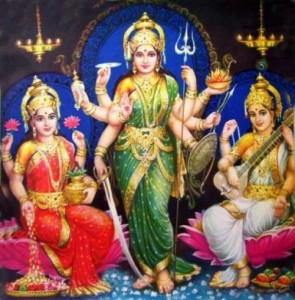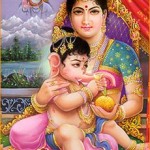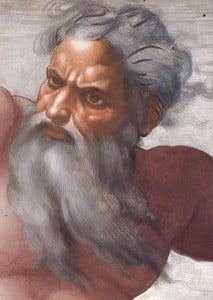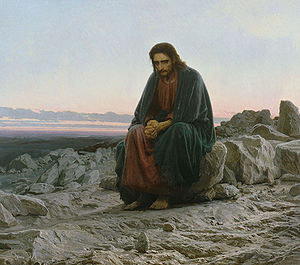I can’t speak for everyone, however given my various experiences last year–especially within Wicca and Catholicism–I cannot deny the power of the feminine aspect of the divine (and for our atheist friends, our human psyche). But what does this have to do with sexuality in the spiritual realm?
Everything.
In a religious landscape (especially here in the West) usually dominated by a divine male figure, there is a vast gulf of perspective left by those who refuse the divine its feminine attributes. Perhaps this is why many who leave the traditional monotheistic models have done so: They are seeking Mother.
It seems ironic that much of our most conservative values revolve around the assumed “complete” family model: Man, woman, child(ren) which is based upon specific religions, however this model is dictated by a male divine figure utterly alone in his masculinity. In all fairness, the Mormons have a pretty interesting theology going on all this.
Yesterday we explored the male nature of the divine and its sexual nature as a penetrating and, dare I say it, “impregnating” force in the world. Today, we will look at the feminine side of the coin.

God the Mother, Nurturer, Embracing, Protector, Teacher, All-Absorbing.
- Our first example comes from the tradition of my most pronounced experience with the divine feminine. The
 Wicca/Pagan Goddess. I should note that the feminine takes many forms across the myriad Pagan traditions, and depending upon the tradition, some or all of the divine females are either all manifestations of one feminine ideal, or distinctly their own “person.” We aren’t here to determine which is correct, I’m simply sharing my experiences. The Goddess has always surprised me. She seduces my heart and mind, and is always fierce in her gentility. During my time with Wicca, I experienced her as a dominant force that loved and bonded with the God aspect in an open and physical way. Life itself proceeded from their holy and passionate coupling. The earth itself is her child and in turn, the womb of all life. She is the young maiden, the mother, and the crone. She is as fierce, wise, and deadly (Athena, Kali, etc.) as she is nurturing and gentle (Demeter, Parvati).
Wicca/Pagan Goddess. I should note that the feminine takes many forms across the myriad Pagan traditions, and depending upon the tradition, some or all of the divine females are either all manifestations of one feminine ideal, or distinctly their own “person.” We aren’t here to determine which is correct, I’m simply sharing my experiences. The Goddess has always surprised me. She seduces my heart and mind, and is always fierce in her gentility. During my time with Wicca, I experienced her as a dominant force that loved and bonded with the God aspect in an open and physical way. Life itself proceeded from their holy and passionate coupling. The earth itself is her child and in turn, the womb of all life. She is the young maiden, the mother, and the crone. She is as fierce, wise, and deadly (Athena, Kali, etc.) as she is nurturing and gentle (Demeter, Parvati).
- Heavenly Mother. So what about that shifty Mormon theology about a divine mother? Without going too far into things, the Latter-day Saints teach that humanity is quite literally the children of God the Father, and that Jesus is his glorified first born (and therefore our literal older brother). The implication is that Mom is around somewhere as stated in Teachings of Presidents of the Church: Joseph F. Smith [1998] 335: “Man, as a spirit, was begotten and born of heavenly parents…” So why not mentioned much in the liturgy or teachings? Many Mormon friends say that she is in the background, shielded and made unknown by God from the blasphemies of humanity. Okay, but I think her presence in the theology displays the selfless nature inherent in the feminine. Despite our modern, feminist leanings, this Mother is known and essential despite her mysterious absence from the obvious front line. In other words, she doesn’t have to be seen to be noticed, doesn’t have to force herself on the scene to be adored. Her very nature as woman and mother swoons her children to seek her. Women seduce their mates and their children with gentility. Why move when you yourself are magnetic?
- Parvati. She is the consort, wife, feminine aspect, energy, life of God himself to the devotees of Shiva. While Shiva

Parvati with her son, Lord Ganesha sits in eternal meditation and contemplation, she animates the universe through him. Shiva is reality and Parvati (she has many names, like Shiva, depending on her role) is its source. In one story, Parvati playfully covered Shiva’s eyes while he was in meditation and therefore plunged the cosmos into darkness. Women, like Parvati, keep us blissfully uncomfortable. I often describe my wife as my Shakti–Parvati’s animating aspect. Energy, life, love, passion…In most images of Shiva and Parvati one finds them side-by-side, embracing, flirting, creating, giving devotion to one another, in darsan with one another (seeing one another). We also see something very interesting within the Hindu faith rarely viewed elsewhere. The Ardhanarishvara, which is an androgynous, composite form of both Shiva and Parvati, is a complete union of both God and Goddess, male and female, into a single mode, function, presence, and ideal. Here we see the beauty and necessity of both male and female blended together. In this aspect, I see Parvati, as woman, seducing and absorbing Shiva (whether a guy is meditating or playing video games, it’s tough getting their attention) to produce this form.
- While Mary, Mother of God is a wholly human personality and not viewed as divine in the Church, I believe her
 attributes of mother and nurturer are nearly unparallelled in the religious world. In one sense, she was actually courted by God himself. In Luke’s gospel (as we explored yesterday), the angel Gabriel shows up and tells Mary God’s plan. He could have just left, but he waited, I think, for Mary’s consent. Mary says in chapter 1 verse 38, “I am the Lord’s servant…May it be as you have said.” The grace and power of the feminine. Even as a mere mortal, the cosmos and its Creator cannot move until woman relents to its advances.
attributes of mother and nurturer are nearly unparallelled in the religious world. In one sense, she was actually courted by God himself. In Luke’s gospel (as we explored yesterday), the angel Gabriel shows up and tells Mary God’s plan. He could have just left, but he waited, I think, for Mary’s consent. Mary says in chapter 1 verse 38, “I am the Lord’s servant…May it be as you have said.” The grace and power of the feminine. Even as a mere mortal, the cosmos and its Creator cannot move until woman relents to its advances.
But there’s a twist.
- What about Jesus Christ? Christians believe he is God in the flesh, and if we believe that God in fact transcends and expresses male and female attributes, does that not include the person of Jesus? Take a look at the man’s life. During his ministry, he woos the crowds with the power of his words, he heals those who approach him, he seduces his disciples from their careers and families to follow him, he gathers the people unto himself, he absorbs the sins of the world, he takes death upon himself, he literally gets nailed! Jesus Christ, in the poetry of his theology, is a spiritual womb, taking the world into himself and through his redemptive, life-giving nature, gives birth to humanity with the “new life” he rattled on about in the gospels. Think about it. It’s fun.
The feminine adds magnetism to the unapproachable divine. The feminine is healing, comforting, attractive, passionate, seductive, life-giving. With the male aspect, I described my year with Project Conversion as the penetrating, seed-delivering force which entered my heart and mind. Studying myself and my journey now, I realize that I am not a complete creature, even within the light of my revealed dharma. No, I am in fact within the womb of the feminine. When the seed of Project Conversion penetrated my life, it fertilized the womb of my heart and soul. Now I am within the Mother, growing in her, developing, reconfiguring the spiritual DNA of my Parents as we all do during spiritual growth. She just wooed me, now she is shaping me into the man I’m meant to be. My experience at the river of my dharma was nothing more than an ultrasound, a snapshot of my reality.

That is the sexuality of the divine feminine in my life. It’s about taking in, absorbing, embracing, shaping. How receptive are you today? How do you see her in your life?

